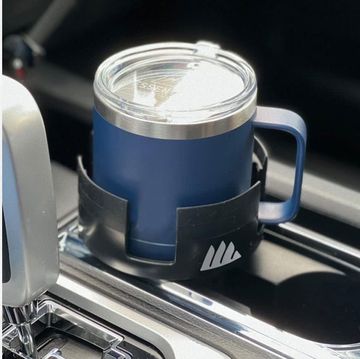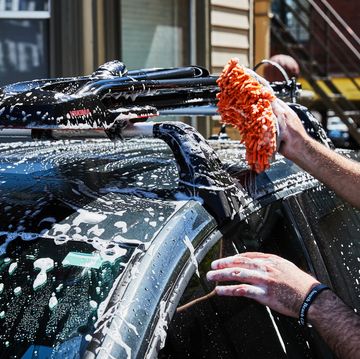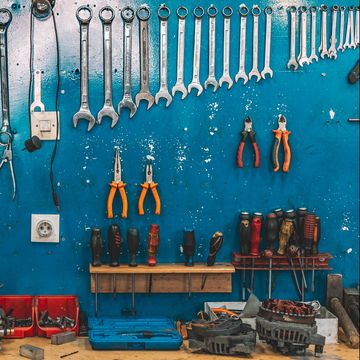Whether you are looking to prep your car for sale, get it clean prior to mechanical surgery, or merely don't want to cringe when you open the hood, a little DIY cleaning will make a world of difference. Here are step-by-step pictures of how to clean an engine. Note: Keep in mind that it is illegal to dump untreated wastewater into sewer gutters. Be sure to clean your engine somewhere you can collect the wastewater and dispose of it properly.
This is our victim for today. A 1996 Chevy Pickup with over 100,000 miles. This truck has been ridden hard and put away wet.
Step 1: Cleaning Products
There are many good products on the market to help you return your engine to almost new appearance.
Step 2: Remove The Battery Cables
Remove the battery cables. Disconnect the negative cable first. The reason to remove the ground first is so thatyou can't short the circuit, releasing enormous amounts of energy in the process. Once the circuit is broken, remove the positive cable and set aside.
Step 3: Extend The Life Of Your Battery
The terminals on these cables had extensive corrosion. 90 percent of all starting and charging problems stem from poor connections. Doing this maintenance regularly will extend the life of your expensive battery, alternator and starter.
Step 4: Clean The Battery Tray
Corrosion is not limited to the cables. Battery trays need periodic cleaning. Loosen and remove the hold down clamp. Some cars have long, skinny J-bolts holding the battery. They may break on removal and need replacing. Here is how to remove a rusted bolt. Also, do not use open flame near a battery. It gives off very flammable hydrogen gas that can explode.
Step 5: Wire Brush The Corrosion
Wire brush the corrosion. You may need some baking soda and water paste to neutralize any spilled acid.
Step 6: Use Rust Resistant Enamel
Once the tray is clean and dry. Give it a good coat of rust resistant enamel. You can touch up other steel parts the same way. Use a piece of cardboard to mask off adjacent parts against over spray.
Step 7: Soak The Cable Ends
Soak the cable ends in a clean tin can filled with CLR or similar corrosion neutralizer. On this GM side terminal cables, I removed the threaded post.
Step 8: Brush Them Squeaky Clean
Use a terminal brush to clean them squeaky clean.
Step 9: Install New Posts
New post and spacer installed. Use dielectric grease to help protect the clean terminals from oxidation. Dielectric grease is non-conductive and water resistant. That may sound counter intuitive but It doesn't interfere with conductivity because of the tight mechanical contact pushes the grease away and seals the connection. Silicone seals on some connectors may be softened by dielectric silicone. Use white grease on these types.
Step 10: Wire Brush Accumulated Rust
Wire brush the hold down bolt to remove any accumulated rust prior to re-installation.
Step 11: Anti-Seize Compound Protects
Coat the threads of the hold down bolt with anti-seize compound to protect if from further corrosion. Replace the battery, install and tighten the hold down.
Step 12: Prepping The Engine
Now we are ready to clean the engine. Cover sensitive electrical parts like the alternator, distributor and engine computer or relay boxes with plastic bags. This will keep them from getting overly soaked. If you have a finicky, older car with a lot of electrical problems you may want to think twice about spraying your engine down. Fix those problems first or at least it will be clean so when you have to fix them after.
Step 13: Remove Loose Dirt
Use compressed air to blow out any loose dirt. A shop vacuum cleaner will also work if you have a small hose extension that will reach into tight spaces.
Step 14: Use Engine Cleaner
Spray the engine cleaner on the greasy engine. Stay away from exposed electrical components. These can be cleaned with non-residue dry brake cleaner.
Step 15: Let It Soak
Be sure to spray into the nooks and crannies that collect grease and dirt. Let it soak in for a while. Take a break and do something else. I waited 30 minutes before rinsing on this engine.
Step 16: Safe Alternative To Degreaser
An alternate to engine degreaser is Simple Green. You can buy gallon jugs at Home Depot or other big box chain stores. Dilute according to directions with water. You can even use piping hot water to dissolve grease faster. Use a siphon sprayer hooked to your air compressor to blast away dirt and grease.These are available from most professional tool sellers and priced from about $15 to over a hundred. When using pressurized sprayers, be careful not to force solvents into electrical connections, engine orifices or sensitive components.
Step 17: Mineral Spirits
You can use mineral spirits and a siphon sprayer to degrease an engine that's removed and going to be rebuilt.
Step 18: Prepping An Engine Block
I also use mineral spirits and compressed air to clean an engine block prior to assembly. A tray under the stand will catch falling detritus for proper disposal. Wear a face shield, "rubber" gloves and OSHA-approved mask to prevent breathing vapors. Clean the bores with paper towels and ATF (Automatic Transmission Fluid). When the paper towels comes out clean it's ready. Leave the ATF oil film on to prevent rust. Keep a big garbage bag over the block when not being worked on.
Step 19: Cleaning Aluminum Parts
I used a small wire brush and CLR to clean the exposed raw aluminum parts. Then went over the aluminum with a 3M Scotch-Brite pad soaked with CLR. Be very gentle with A/C lines as they are under pressure.
Step 20: Scrub Plastic Parts
Scrub the plastic with a stiff plastic bristle brush and then a sponge with soapy water. Rinse with clear water and dry with paper towels or compressed air.
Step 21: Use Brake Cleaner
Brake cleaner will help remove grease from tricky areas and then dry cleanly without any residue.
Step 22: Repeat, Rinse And Dry
Once dry, you may need to repeat cleaning some areas with soapy water. Final rinse with clear water and let dry completely before starting the engine. This may only take an hour or so if the ambient temperature is hot, or overnight if it's cool and humid. Every engine is different to how much sitting water it can tolerate. If in doubt, let it dry.
Step 23: Check For Oil Leaks
Once the engine has been cleaned, you'll want to see if a small leak is causing the greasy build up. An easy way to check is with special UV dye for oil leaks. I bought the dye at NAPA for less than $5 a bottle. Add the special oil-specific dye directly into to the oil fill. You won't need to change the oil after checking for leaks. It won't hurt anything. Start the engine and drive it around until the system gets to normal temp and the dye circulates.
Step 24: Check For Coolant Leaks
There's also a compatible dye for coolant leaks. You may need to drain out a little bit of coolant to add the dye to the radiator. If you have a leak it may be already low. Some systems, like this truck, need two bottles of dye because of the large volume of coolant. Don't add it to the overflow bottle because it won't get into the engine quickly or in sufficient quantity to see easily.
Step 25: Check Radiator Pressure
Check the coolant system to see if it's holding pressure. If it's not, the dye will indicate the location of the leak.
Step 26: Spot The Dye
You don't need to buy a high dollar black light to see the dye. Any bright source of blue to ultraviolet light will work. Mag Instruments sells an accessory kit for the ubiquitous Mini Mag flashlight that has a blue colored lens. Less than $10 at most outdoor stores. If you have the LED conversion it's even brighter than the normal intensity.
Step 27: Check For Leaks
Use the blue lens on your Mini Mag flashlight to find any leaks. The dye will glow and make the source of the leak obvious. You'll want to do this in the shade and away from direct sunlight. This engine didn't have any external leaks that I could see, even at night.
Step 28: All Done
All done! Looks much better now plus it will be a pleasure to work on now that it's clean.
Save this article for later by pinning it. For more ideas, follow Popular Mechanics on Pinterest.













